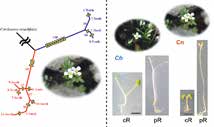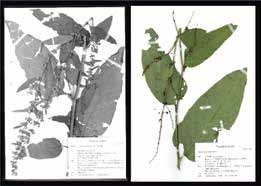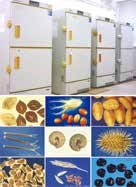Research Area : Plant Diversity and Evolution
Evolution of photoreceptors

Modifying sensitivities to environmental signals is one of fundamental mechanisms for plants to optimize adaptive responses to environmental differences and lead to their diversification on the earth. Since photoreceptors play pivotal roles for plants to sense environmental signals and adjust their physiological responses such as germination and flowering, natural variations on photoreceptors are possibly responsible for such adaptive evolution in plants. I have advanced taxonomical reevaluation based on morphology and molecular phylogeny on family Dioscoreaceae, Cyperaceae, etc. For conserving local populations of endangered plant species, I am investigating their fluctuation, and studying on hybridization and genetic disturbance of the species (e.g., Rumex nepalensis subsp. andreaeanus). For ex-situ conservation, preserving frozen seeds from the local populations of endangered plants was started.
By focusing on phytochromes, we performed multiple approaches including molecular evolution, plant physiology, and genetics and attempt to (1) explore natural variation on phytochrome genes, (2) investigate physiological as well as phenotypic changes that were conferred by amino-acid changes on phytochromes, (3) unravel molecular mechanisms underlying phenotypic variations.
Phylogeography of alpine plants and molecular basis of adaptation to regional environments

Alpine as well as arctic-alpine plants have specifically extensive ranges in the northern hemisphere and plausibly encounter various environments at some parts of their ranges. We are interested how alpine plants adapt to such various environments.
By conducting phylogeographic studies, (1) we attempt to examine whether adaptation is responsible for genetic changes or phenotypic plasticity. If genetic changes are responsible for adaptive divergences, we have two further questions: (2) what kind of genes are important for adaptive divergence and (3) is there any mechanisms (genes) that are shared across various species. In addition to these evolutionary interests, we are interested in how alpine communities have been established following the past climate changes, especially glacial and interglacial cycles during the late Pleistocene.
Research Area : Plant Diversity and Evolution
Study on plant systematics and conservation

I have advanced taxonomical reevaluation based on morphology and molecular phylogeny on family Dioscoreaceae, Cyperaceae, etc. For conserving local populations of endangered plant species, I am investigating their fluctuation, and studying on hybridization and genetic disturbance of the species (e.g., Rumex nepalensis subsp. andreaeanus). For ex-situ conservation, preserving frozen seeds from the local populations of endangered plants was started.
Genetic Resources of Wild Plants

A herbarium is available for studies on weekdays. About 80,000 specimens of 6,000 wild plant species from Japan and other countries have been preserved under APG system. They include various weeds from the world, naturalized plants in Japan, endangered species, plants of Ryukyu, and so on. About 30,000 seed specimens are also available. ca. 17,000 frozen seed accessions of 3,500 species from wild populations are also available only for scientific studies. Those are not guaranteed for survival rate. Exchanging MTA is needed before using frozen seeds. Please contact me



